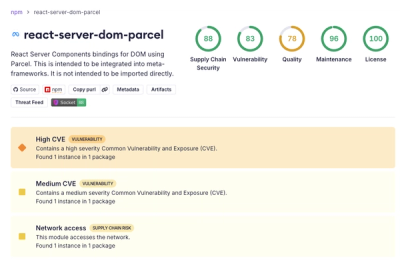
Security News
Deno 2.6 + Socket: Supply Chain Defense In Your CLI
Deno 2.6 introduces deno audit with a new --socket flag that plugs directly into Socket to bring supply chain security checks into the Deno CLI.
react-mapexplorer
Advanced tools
A react component used to display a Map Explorer from chainscript.
Live demo: stratumn.github.io/react-mapexplorer
To build the examples locally, run:
npm install
npm start
Then open localhost:8000 in a browser.
The easiest way to use react-mapexplorer is to install it from NPM and include it in your own React build process (using Browserify, Webpack, etc).
You can also use the standalone build by including dist/react-mapexplorer.js in your page. If you use this, make sure you have already included React, and it is available as a global variable.
npm install react-mapexplorer --save
Simply include the MapExplorer component in your React application:
var MapExplorer = require('react-mapexplorer').MapExplorer;
// OR with ES6 import
import { MapExplorer } from 'react-mapexplorer';
<MapExplorer mapId={mapId} applicationUrl={applicationUrl} />
mapId: The ID of the map that should be displayed
applicationUrl: The remote URL listened by the agent.
chainscript: A JSON chainscript.
evidenceComponent: An optional component used to rendered the evidence associated with a segment (uses the BitcoinEvidence component by default)
Either (mapId and applicationUrl) OR chainscript must be set.
If you'd like to develop your own evidence component, you can have a look at src/DummyEvidence.js for instance.
src, lib and the build process)NOTE: The source code for the component is in src. A transpiled CommonJS version (generated with Babel) is available in lib for use with node.js, browserify and webpack. A UMD bundle is also built to dist, which can be included without the need for any build system.
To build, watch and serve the examples (which will also watch the component source), run npm start. If you just want to watch changes to src and rebuild lib, run npm run watch (this is useful if you are working with npm link).
Copyright 2017 Stratumn SAS. All rights reserved.
Unless otherwise noted, the source files are distributed under the Apache License 2.0 found in the LICENSE file.
FAQs
React component that displays a Chain Map
The npm package react-mapexplorer receives a total of 1 weekly downloads. As such, react-mapexplorer popularity was classified as not popular.
We found that react-mapexplorer demonstrated a not healthy version release cadence and project activity because the last version was released a year ago. It has 1 open source maintainer collaborating on the project.
Did you know?

Socket for GitHub automatically highlights issues in each pull request and monitors the health of all your open source dependencies. Discover the contents of your packages and block harmful activity before you install or update your dependencies.

Security News
Deno 2.6 introduces deno audit with a new --socket flag that plugs directly into Socket to bring supply chain security checks into the Deno CLI.

Security News
New DoS and source code exposure bugs in React Server Components and Next.js: what’s affected and how to update safely.

Security News
Socket CEO Feross Aboukhadijeh joins Software Engineering Daily to discuss modern software supply chain attacks and rising AI-driven security risks.